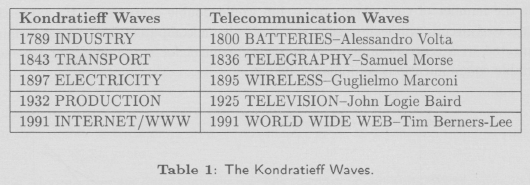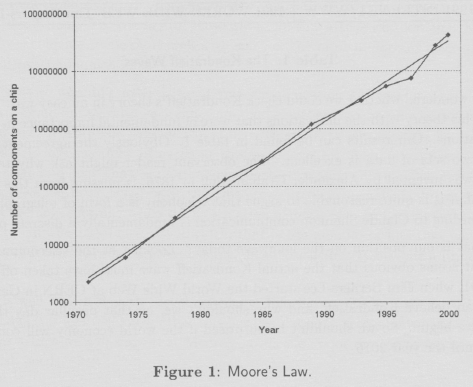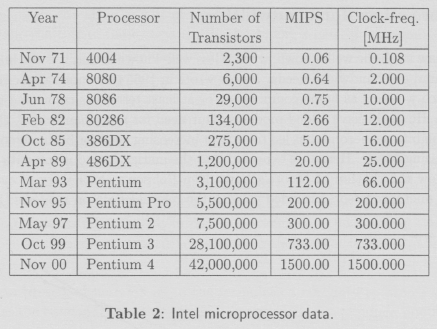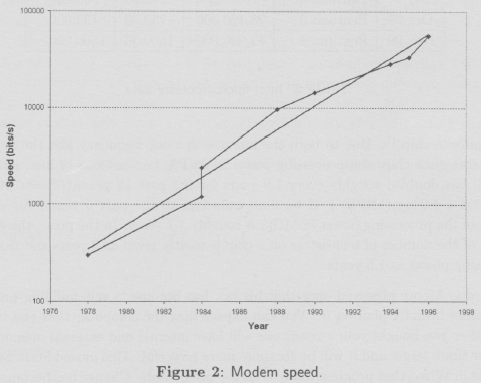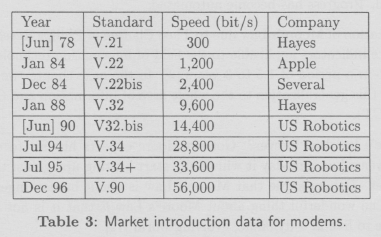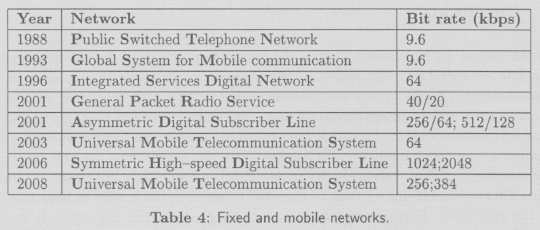Services on Demand
Journal
Article
Indicators
-
 Cited by SciELO
Cited by SciELO -
 Access statistics
Access statistics
Related links
-
 Similars in
SciELO
Similars in
SciELO
Share
Acta Nova
On-line version ISSN 1683-0789
RevActaNova. vol.2 no.1 Cochabamba Dec. 2002
Divulgación Científica
The Iron Laws that Rule the ICT Markets
Johannes W. Meijer
KPN Royal Dutch Telecom
Utrecht, The Netherlands
e-mail: j.w.meijer@kpn.com
1 Introduction
The history of telecommunications started in the year 1800. This doesn't imply that before 1800 people didn't try to bridge distance and time in inventive ways. Many of them did and quite interesting methods were used. The Incas for example used quipus, knotted cords of different colors that conveyed specific data, and chasquis, specially trained runners, to convey messages between Cuzco and Quito, a distance of 2000 kilometers, in just ten days. In 1800 the modern era of telecommunications started however in earnest with the discovery of the battery by Alessandro Volta. A discovery whose importance can't be underestimated. Mobile telecommunications for example wouldn't exist without Volta's batteries which enable us to move around freely with our handheld at the ready.
It was Nikolai Kondratieff who discovered that innovations come in waves and that Volta's batteries belonged to the first of these waves. In this article we show that Kon-dratieff's waves coincide remarkably well with some of the most important discoveries in the área of telecommunications.
Modern society wouldn't exist without telecommunication systems and services. The ability to communicate with each other anytime anywhere has become an essential aspect of our age. If Abraham Maslow would be alive today we suspect that he would put bandwidth in his hierarchy of needs at the same level as our physical needs like food, drink, sleep and sex. The need for bandwidth starts manifesting itself early in the morning when we log in at home or at the office to collect our e-mail, and it ends at three o'clock the next morning when the information highway is free of traffic jams and we are able to transfer large files. Bandwidth, that is the number of bits that can be transmitted per second through a given channel, has most definitely become a primary need.
While it is well known that the developments in Information Technology are driven by Moore's Law, it is less well known that this law enables us to access information ever faster. In this article we will show that Moore's law is the major driving factor behind our bandwidth needs.
2 Innovations in telecommunications
When the Russian economist Nikolai Kondratieff plotted in 1926 commodity prices, wages and other economic statistics, he discovered that they fluctuated in cycles of 50 to 60 years [6]. Years of prosperity were followed by years of decline. That was not exactly what Karl Marx had predicted. So what on earth was going on? It occurred to Kondratieff that his long waves were largely a technological phenomenon. Research going back to 1800 indicated that basic technological innovations emerged in clusters. While it is widely agreed that the gains in living standards we enjoy can be attributed to technological innovations, few are aware that innovations are generated cyclically. In the 1930s the Austrian economist Joseph Schumpeter became the most influential proponent of the long wave theory. He advocated the theory of innovation. Others followed in his footsteps. The 1987 Nobel Prize winner Robert Solow showed that technological development will be the motor for economic growth in the long run. According to Solow's model for economic growth, if continuous technological progress can be assumed, growth in real incomes will be exclusively determined by technological progress.
We wondered whether we could check Kondratieff's theory in an easy way. We tried to link his theory with the innovations that were of fundamental importance in telecommunications. Our results can be found in table 1. Obviously the agreement between these two sets of data is excellent. The observant reader might ask why telephony, which was invented by Alexander Graham Bell in 1876, is missing from this list. We think that it is quite reasonable to argue that telephony is a form of telegraphy. After all according to Claude Shannon communication is fundamentally a discrete process.
What is our position on the longwave today? Looking at the telecommunication waves it seems obvious that the actual Kondratieff wave must have taken off on May 17, 1991, when Tim Berners-Lee started the World Wide Web at CERN in Geneva. So if we can believe Kondratieff, and why shouldn't we, on that peculiar day the latest longwave begun. So we shouldn't be surprised if the world economy will continue to grow until the year 2016.
3 More about Moore's Law
On December 29, 1959, Richard Feynman, who won the Nobel Prize for Physics in 1965, gave a speech at the annual meeting of American Physical Society with the title 'There's plenty of room at the bottom!' He defiantly invited his audience to enter this new and exiting field of physics. He explained that is was quite possible from a physical point of view to write the entire 24 volumes of the Encyclopedia Britannica on the head of a pin. In the year 2000, he said, when people look back at this age, they will wonder why it was not until the year 1960 that anybody began seriously to move in this direction. At the end of his speech Feynman challenged his audience with the offer of a prize of $ 1.000 to the first guy who could take the information on the page of a book and put it on an area 1/25,000 smaller in linear scale in such manner that it could be read by an electron microscope [5].
That very same year Robert Noyce and Gordon Moore at Fairchild Semiconductor had already taken up this challenge by inventing the integrated circuit. Let's see what happened during the next 40 years. In 1959, year zero the number of components on an integrated circuit was only one. In 1962, it was 8. By 1963, it had increased to 16, in 1964 to 32, and in 1965, it reached 64. At that point, Moore predicted that: 'With unit costs falling as the number of components per circuit rises, economics may dictate squeezing as many as 65,000 components on a single chip by 1975.' Moore predicted that the number of components on a chip would double every year. He wrote that: 'Integrated circuits will lead to such wonders as home computers - or at least terminals connected to a central computer - automatic control for automobiles, and personal portable Communications equipment.' [9].
For the past 30 years the number of transistors on a chip has doubled with almost clockwork precision roughly every 2.1 years, instead of every year as Moore predicted in 1965 (Figure 1 and Table 2), [R2 = 0.9943; Year= 1947 + 2.131og2(number of components on a chip)]1. Due to both the increase in clock frequency and the number of transistors on a chip, the processing power in MIPS, i.e. millions of instructions per second, has doubled roughly every 1.9 years for the past 15 years [R2 = 0.992; Year = 1981.4 + 1.9log2(MIPS)]. If we limit ourselves to the past 5 years, the doubling period of the processing power in MIPS is roughly 1.7 years. In the press, the doubling period of the number of transistors on a chip is mostly given as 2 years and that of the processing power as 1.5 years.
Gordon Moore observed once that his law has become 'a self-fulfilling prophecy'. Companies literally plan on it. You can expect that the computer that you buy four years after you bought your current one will have internal and external memories that are four times larger and it will be six times more powerful. This moved Steve Steinberg to write in Wired that progress today is all too predictable. Change has become routine and uneventful. Progress has become automated.
A generalization of Moore's Law due to Theo Claasen of Philips Research states that all performance indicators applicable to the field of information technology improve by a factor of two in a period of 1.5 to 3 years [2]. In the next chapter we will show that we can extend this generalization to the whole area of Information and Communication Technology (ICT).
Will Moore's law last forever? Gordon Moore expects his law to continue for at least 10 to 15 years but someday it will finally start butting up against the finite size of atomic particles. Others argue that Moore's Law is about human ingenuity progress, not physics. The wonderful thing about Moore's Law is that it is not a static law, it forces everyone to live in a dynamic, evolving world [12].
4 Moore's Law for bandwidth
Moore's Law might be well-known, what is less well-known is that it is the major driving factor behind our bandwidth needs. Moore wrote in 1965 that integrated circuits would lead to such wonders as home computers - or at least terminals connected to a central computer. He could have added modems. Our need for more bandwidth, that is more information bits per second, has led to an ever increasing need for both memory capacity and processing power. Hence we expected that the market introduction data of modems would follow the rhythm of Moore's Law. Ken Polsson's chronology of events in the history of microprocessors provided us with the relevant data on modems [10].
The doubling time of modem speed is roughly every 2.43 years (Figure 2 and Table 3) [R2 = 0.9943; Year = 1958.5 + 2.43log2(bit rate)]. Between 1978 and 1996 modem costs were all important while PSTN transmission costs were a transparent factor for all modem speeds. Clearly the cost of a modem depends on the chips that are used to make it, while the cost of these chips is ruled by Moore's Law. So the doubling time of modem speed is a direct consequence of Moore's Law.
Does the LAN community follow a different path? Let's take a look at the introduction data of local area networks (LANs). The first experimental Ethernet LAN was built by Metcalfe and Boggs at Xerox Parc in 1976. Ethernet (10 Mbit/s) hit the market in 1982, Fast Ethernet (100 Mbit/s) in 1990 and Gigabit Ethernet (1000 Mbit/s) in 1998. So LAN speeds used to double roughly every 2.4 years which confirms the doubling time given above. It is interesting to observe that the standardization process for 10 Gigabit Ethernet (10,000 Mbit/s) was finalized in June 2002 four years ahead of the expected date. Whether this implies a quickening of the doubling time for LAN speeds depends of course on a positive reaction of the market for 10 Gigabit Ethernet LANs.
The data presented here led us to the formulate a corollary to Moore's Law. We observe that the bandwidth provided for by communications equipment doubles roughly every 2.5 years [8].
5 Speed isn't Everything. It's the Only Thing
Figure 2 shows us that in 1996 the ISDN era was about to begin. All efforts in the mid eighties to introduce ISDN in the European market had proved to be costly failures as is well-known today. Moore's Law tells us why. Only in 1996 we could expect prices for ISDN to have reached a level acceptable to our customers. Before 1996 only customers with special needs, like e.g. the graphical industry, were willing to pay the high prices for ISDN. ISDN broke through in the Dutch market in 1996 when it passed the level of 100,000 users. ISDN made it possible to access the Internet at 64 kbps or 128 kbps. At that time this was an incredibly fast speed especially for those who remembered 1988 when a 9.6 kbps modem was state of the art. Fast is however never fast enough and in 1996 the ADSL Forum was already looking for ways to access the Internet even faster. We had to wait until 2001 to see the number of ADSL users in the Netherlands surpass the 100,000 level. In 2001 typical ADSL transmission speeds were 512 kbps download and 128 kbps upload or 1024 kbps download and 256 kbps upload. Looking beyond ADSL it looks like SHDSL, a technology for services of up to 2.3 Mbps that require equal up and download speed, might become the next access network technology. More information about the challenge of bringing broadband to the customer can be found in a FITCE'01 Barcelona congress paper by Geert Dobbelaere [4] and a FITCE'02 Genoa congress paper by Walter Cuypers [3].
Are these developments in line with Moore's law? We observed in 2001 an increase by a factor 8 in transmission speed in only 5 years, i.e. a doubling period of roughly 1.6 years. This doubling period is considerably lower than the expected period of 2.5 years given above. There were two reasons for this remarkable phenomenon. One reason was that for fixed network operators it is better to get the Internet traffic off the ISDN network as early as possible. The other reason was that cable companies turned out to be strong competitors in the market for heavy Internet users forcing other fixed network operators to come up with an appropriate ADSL alternative as early as possible. Recently however many ISP's (Internet Service Providers) in the Netherlands have started to offer ADSL Lite, i.e. 256 kbps download and 64 kbps upload, at very competitive prices to the rest of their customers. This development suggests that Moore's Law seems to prevail in this market once again.
6 Mobile networks from 2G to 3G
Let's turn our attention to mobile networks. GSM networks, second generation mobile networks, were introduced in most European countries around 1993. GSM networks can carry 9.6 kbps of data, which is of course only nice for relatively simple WAP (Wireless Application Protocol) services. Most GSM networks haven't advanced to higher bit rates. What did happen was that since 1993 the number of users of GSM networks increased at an almost incredible rate. In the Netherlands this was not in the least due to the ability to get a free GSM handheld from any of the five different operators. Handhelds that, with special thanks to Moore's Law, became smaller, less weighty and more functional every year. Last year, in 2001, all over Europe mobile network operators were busy building GPRS, or 2.5G, networks and introducing GPRS services. GPRS bit rates of up to and even above 100 kbps were said to be possible but much lower data transfer rates seemed likely at least in the initial stages. This was confirmed by Giuseppe Putorti who reported at the FITCE'02 Genoa congress that with the products available today only 40 kbps downlink and 20 kbps uplink throughput is consistently achievable [11]. Although GPRS is currently available in many countries at present less than one percent of the GSM users are regular GPRS users. The GPRS bit rates are of course an improvement with respect to the GSM bit rates but they are still low compared to the bit rates that can be offered with UMTS networks. So it remains to be seen whether customers will pick up GPRS or that they will skip it and wait for UMTS instead.
In august 2001 Vodafone announced to the surprise of the financial markets that it would introduce its UMTS, or third generation mobile, network with a minimum service level at the outline fringe area of the network of 64 kbps. The launch of UMTS services by Vodafone was planned for the second half of 2002. Higher speeds like 384 kbps and 2 Mbps, which are needed for good quality video communication links, would be introduced at a later date. Should this have come as a surprise to anyone? I don't think so. According to Moore's Law we require 13 years to get from 9.6 kbps to 384 kbps assuming a doubling rate of 2.5 years. By that time we will see the year 2006, i.e. 1993 plus 13, appear on our calendars. In a similar way we can calculate that we would need at least 7 years to reach the 64 kbps target, i.e. until the year 2000. Looking at it from a different angle we observe that mobile data bit rates lag those of fixed networks by approximately 5 years, i.e. 1988 versus 1993 for 9.6 kbps. So we could expect 64 kbps on our mobile networks in 2001, i.e. five years after ISDN became a success on our fixed networks. From both perspectives the introduction of 64 kbps on UMTS networks in 2002 looked all right. Markus Blume presented results of the UMTS field trials of T-Mobile at the FITCE'02 Genoa congress that coincide quite nicely with this view. He reported the first 64 kbps packet switched data call on the T-Mobile network and noted that in the next few years the most common UMTS bearers will be 64 kbps, 128 kbps and 384 kbps and certainly not the 'marketing promise of 2 Mbps' [1].
A critical issue continues to be the availability of suitable UMTS terminals. Giuseppe Putorti gave as his opinion at the FITCE'02 Genoa congress, where he presented a paper about the evolution of handsets technology from 2G (GSM) to 3G (UMTS), that one or two years are still needed to develop the 'perfect' UMTS mobile phone [11]. He made it quite clear that the interoperability of UMTS handsets and networks still need a lot of testing and that the available UMTS handsets are not ready for a mass market launch yet. So it is quite understandable that most UMTS operators have delayed the launch of their first commercial UMTS service until 2003.
We observe that mobile networks are two steps behind fixed networks in terms of transmission speed (Table 4). The same will probably be the case for the services on these networks. We wouldn't be surprised if these services will evolve along different lines. The unexpected success of SMS (Short Message Service) and the sudden appearance of a market for ringing tones show that this is a real and exciting prospect. There is however a sobering factor that we have to reckon with and that is that it normally takes years for even a compelling new service to be widely accepted in the market. It seems unlikely that UMTS services will be an exception to this rule.
So what happened to all those experts who believed that UMTS would become the next overnight success story? Apparently they fell into what we would like to call Licklider's trap. It was J.C.R. Licklider, one of the originators of the Internet, who wrote in his book Libraries of the Future (1965) that: "People tend to overestimate what can be done in one year and to underestimate what can be done in five or ten years."[7]. UMTS is clearly a text book example with respect to the first part of this statement. One only has to consider the euphoria, in retrospect the sheer incredible euphoria that surrounded UMTS in the year 2000, which ended with the now infamous auctions for UMTS licenses in Europe, to agree with Licklider. Fortunately if the second part of Licklider's statement holds true we can expect that in the next five years UMTS will take off and that in ten years time everything will turn out the way everybody always expected it to be.
7 Conclusions
In this article we have shown that in the information and communication technology markets Moore's Law rules supreme. What Moore's Law basically tells us is that it takes between 1.5 and 3 years before the next generation of ICT equipment reaches the market at prices that a large number of people are willing to pay. A corollary to Moore's Law was introduced that states that the bandwidth provided for by telecommunications equipment doubles roughly every 2.5 years. With our corollary we are able to predict the occurrence of future events in the areas of fixed and mobile communications. UMTS with 256 kbps handhelds e.g. can be expected to arrive at the market in large numbers in the year 2008. Events in the ICT markets happen fast, but not infinitely fast, as some people tend to believe.
Notes
1 There is a quick and simple way to determine the doubling time from a logarithmic graph. Figure 1 tells us that it took Intel about 21 years to put a 1000 times more components on a chip. We know that 1000 ![]() 210. From these data we conclude that the doubling time must be 21/10 = 2.1 years.)
210. From these data we conclude that the doubling time must be 21/10 = 2.1 years.)
References
[1] Markus Blume. T-Mobile UMTS field trials. In Proceedings of the 40th European Telecommunications Congress, pp 177-179, Genoa, Italy, September, 2002.
[2] Theo Claasen. Philips Research. Private communication. [ Links ]
[3] Walter Cuypers. KPN Belgium case study - BTS backhaul over SHDSL. In Proceedings of the 40th European Telecommunications Congress, pp 104 - 109, Genoa, Italy, September, 2002.
[4] Geert Dobbelaere. Bringing broadband to the customer, technology positioning from belgacom's point of view. In Proceedings of the 40th European Telecommunications Congress, pp 49-53, Barcelona, Spain, August, 2001. http://www.fitce.org.
[5] Richard Feynman. There is plenty of room at the bottom. Presentation at the annual meeting of the American Physical Society, Dec. 29, 1959. http://www.zyvex.com/nanotech/feynman.html.
[6] Nikolai Kondratieff. Die langen Wellen der Konjunktur (The long waves in economic life), Vol. 56. Archiv fur Sozialwissenschaft und Sozialpolitik, pp 573 - 609, 1926.
[7] J.C.R. Licklider. Libraries of the Future, p 17, 1965.
[8] Johannes W. Meijer and Marcel Geraads. Convergence and Divergence in Business Communications, Vol. 17, part 2. British Telecommunications Engineering, pp 182-186, 1998.
[9] Gordon E. Moore. Cramming more components onto integrated circuits. Electronics, April 19, 1965. http://www.intel.com/research/silicon/mooreslaw.htm. [ Links ]
[10] Ken Polsson. Chronology of events in the history of microprocessors 1947-1998. http://www.islandnet.com/~kpolsson/comphist/. [ Links ]
[11] Giuseppe Putorti. Handsets technology evolution from 2G to 3G: a long journey in a short time. In Proceedings of the 40th European Telecommunications Congress, pp 194-197, Genoa, Italy, September, 2002.
[12] Robert R. Schaller. Moores law, past, present and future. IEEE Spectrum, June 1997. http://mason.gmu.edu/~rschalle/moorelaw.html. [ Links ]













